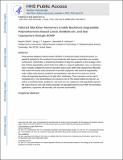Tailored silyl ether monomers enable backbone-degradable polynorbornene-based linear, bottlebrush and star copolymers through ROMP
Author(s)
Shieh, Peyton; Nguyen, Hung V. -T.; Johnson, Jeremiah A.
DownloadAccepted version (827.0Kb)
Publisher Policy
Publisher Policy
Article is made available in accordance with the publisher's policy and may be subject to US copyright law. Please refer to the publisher's site for terms of use.
Terms of use
Metadata
Show full item recordAbstract
Ring-opening metathesis polymerization of norbornene-based (macro)monomers is a powerful approach for the synthesis of macromolecules with diverse compositions and complex architectures. Nevertheless, a fundamental limitation of polymers prepared by this strategy is their lack of facile degradability, limiting their utility in a range of applications. Here we describe a class of readily available bifunctional silyl ether-based cyclic olefins that copolymerize efficiently with norbornene-based (macro)monomers to provide copolymers with backbone degradability under mildly acidic aqueous conditions and degradation rates that can be tuned over several orders of magnitude, depending on the silyl ether substituents. These monomers can be used to manipulate the in vivo biodistribution and clearance rate of polyethylene glycol-based bottlebrush polymers, as well as to synthesize linear, bottlebrush and brush-arm star copolymers with degradable segments. We expect that this work will enable preparation of degradable polymers by ROMP for biomedical applications, responsive self-assembly and improved sustainability. ©2019, The Author(s), under exclusive licence to Springer Nature Limited.
Date issued
2019-10Department
Massachusetts Institute of Technology. Department of ChemistryJournal
Nature Chemistry
Publisher
Springer Science and Business Media LLC
Citation
Shieh, Peyton et al., "Tailored silyl ether monomers enable backbone-degradable polynorbornene-based linear, bottlebrush and star copolymers through ROMP." Nature Chemistry 11, 12 (December 2019): 1124–32 doi. 10.1038/s41557-019-0352-4 ©2019 Authors
Version: Author's final manuscript
ISSN
1755-4349